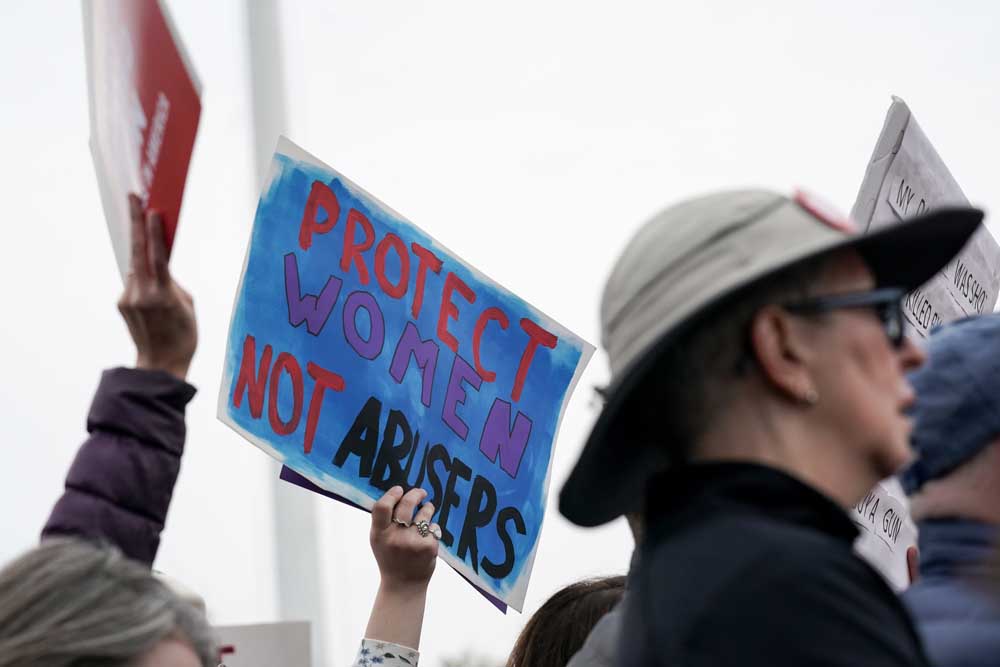not for web
Published 9:00 pm Friday, March 1, 2024

- Gun safety and domestic violence prevention organizations hold a rally in front of the United States Supreme Court to call on the Justices to disarm domestic violence perpetrators and protect survivors as oral arguments are heard in the case of United States v. Rahimi on November 7, 2023, in Washington, D.C.
By the time Deven Grey shot her boyfriend in 2017, he had been isolating and abusing her for years. The night she killed him at their home in rural Alabama, he had fired a gun at her, pistol-whipped her and strangled her with a hose. In court, she filed a “stand your ground” self-defense claim — which she was denied because she had shot her abuser five minutes after he had lain on the couch. “I just didn’t want it to be me,” she said.
She took a guilty plea for manslaughter and was sentenced to 15 years in prison.
For years, I’ve interviewed women around the world who resorted to violence to survive. I have studied hundreds of cases of abused women who were prosecuted for defending themselves and interviewed dozens more in prison. The more I’ve learned about these women, many of whom picked up a gun or knife after decades of abuse, the better I have come to understand that sometimes, the vulnerable must turn to violence to live — and the American legal system is not built to conform to this reality.
One U.S. study found women are twice as likely as men to be convicted of a crime after claiming self-defense; the odds are even worse for a woman of color. (Grey, for instance, is Black; her abuser was white.) Women are asked why they did not leave an abuser, why they were an imperfect victim or why they did not seek help from the police or courts — institutions that failed to protect them in the first place.
These cases should be treated as self-defense. But our self-defense laws — written originally by and for white men defending their property, not for women who might be experiencing domestic or sexual abuse — require a threat to be imminent. They do not take into account that an abused woman often cannot defend herself at the precise moment of an attack. And they do not take into account that she might have been under assault for years.
Stand-your-ground laws are even more flawed. … As Caroline Light, a Harvard University lecturer and author of the book “Stand Your Ground: A History of America’s Love Affair with Lethal Self-Defense,” put it, these laws, despite their seemingly neutral language, were “crafted in a way that would slam the door on abuse survivors while enabling more homicidal violence, especially armed violence, by the usual suspects.”
Many people call for peaceful ways out of abuse. The problem is, these often don’t work. Some women never report the violence out of fear of retaliation from their abuser. Others report it but no action is taken — or they report it, or attempt to leave their abusers, and are killed before the authorities respond. When a woman fights back, she is often treated not as a longtime victim, but as a criminal.
Rachel White-Domain, who heads the Women & Survivors Project at the Illinois Prison Project, said that some of her clients have been “in constant positions of terror and violence,” and that after enduring so much, it’s no wonder some see no other way out. Because women and men are often different sizes and strengths, women are more likely to defend themselves with guns or knives, while men more often use hands and fists. But prosecutors and judges, “people on the other side of the looking glass, just don’t live those kinds of lives” of continuous violence, and so fail to put a woman’s response in proper context.
It is a common prosecutorial tactic to try to discredit an abused woman by making her seem unreasonable for believing she was in danger.
Consider the case of Brittany Smith, an Alabama woman who shot and killed her rapist and was charged with murder. When claiming self-defense, Smith was told by the prosecutor that her rapist had not had a weapon on him. Smith protested that the man’s hands and penis had been weapons. Her rape kit documented 33 wounds. She said she was afraid she’d die — but the court wasn’t convinced. She pleaded guilty to murder and was sentenced to 20 years in prison.
Since the 1970s, some attorneys have used a theory and defense called “battered-woman syndrome,” which helps courts give proper consideration to an abused woman’s experiences. Today, more defense attorneys are arguing that their abused clients’ actions constitute self-defense.
But our self-defense laws must expand to acknowledge the dynamics of intimate-partner violence, especially around timing and what constitutes reasonable fear. When the law does not acknowledge this, it is much more difficult for attorneys to invoke self-defense laws for their abused clients. The fact that they can’t is a double standard that hurts survivors.




